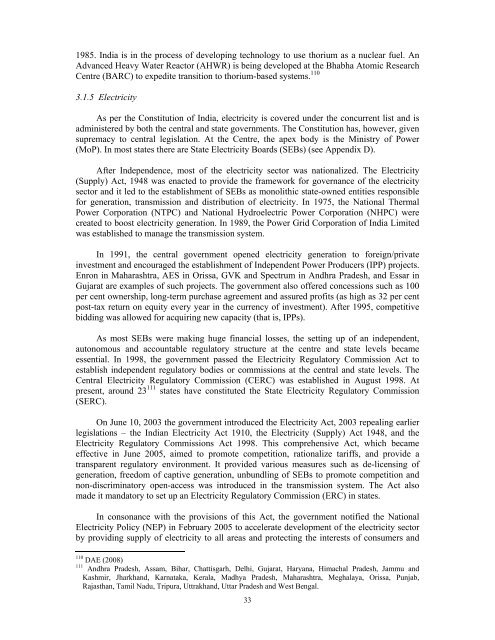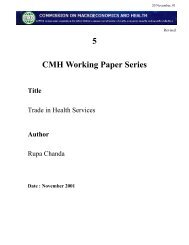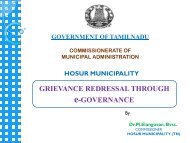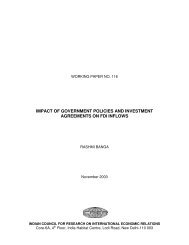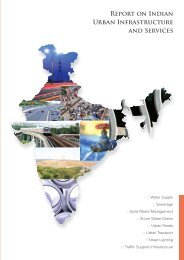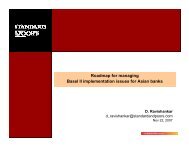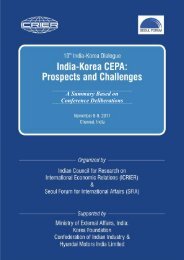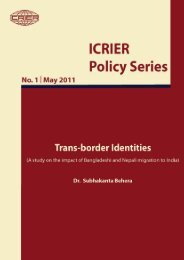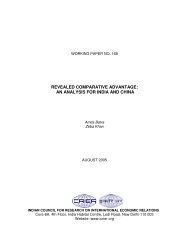Arpita Mukherjee Ramneet Goswami January 2009 - icrier
Arpita Mukherjee Ramneet Goswami January 2009 - icrier
Arpita Mukherjee Ramneet Goswami January 2009 - icrier
Create successful ePaper yourself
Turn your PDF publications into a flip-book with our unique Google optimized e-Paper software.
1985. India is in the process of developing technology to use thorium as a nuclear fuel. An<br />
Advanced Heavy Water Reactor (AHWR) is being developed at the Bhabha Atomic Research<br />
Centre (BARC) to expedite transition to thorium-based systems. 110<br />
3.1.5 Electricity<br />
As per the Constitution of India, electricity is covered under the concurrent list and is<br />
administered by both the central and state governments. The Constitution has, however, given<br />
supremacy to central legislation. At the Centre, the apex body is the Ministry of Power<br />
(MoP). In most states there are State Electricity Boards (SEBs) (see Appendix D).<br />
After Independence, most of the electricity sector was nationalized. The Electricity<br />
(Supply) Act, 1948 was enacted to provide the framework for governance of the electricity<br />
sector and it led to the establishment of SEBs as monolithic state-owned entities responsible<br />
for generation, transmission and distribution of electricity. In 1975, the National Thermal<br />
Power Corporation (NTPC) and National Hydroelectric Power Corporation (NHPC) were<br />
created to boost electricity generation. In 1989, the Power Grid Corporation of India Limited<br />
was established to manage the transmission system.<br />
In 1991, the central government opened electricity generation to foreign/private<br />
investment and encouraged the establishment of Independent Power Producers (IPP) projects.<br />
Enron in Maharashtra, AES in Orissa, GVK and Spectrum in Andhra Pradesh, and Essar in<br />
Gujarat are examples of such projects. The government also offered concessions such as 100<br />
per cent ownership, long-term purchase agreement and assured profits (as high as 32 per cent<br />
post-tax return on equity every year in the currency of investment). After 1995, competitive<br />
bidding was allowed for acquiring new capacity (that is, IPPs).<br />
As most SEBs were making huge financial losses, the setting up of an independent,<br />
autonomous and accountable regulatory structure at the centre and state levels became<br />
essential. In 1998, the government passed the Electricity Regulatory Commission Act to<br />
establish independent regulatory bodies or commissions at the central and state levels. The<br />
Central Electricity Regulatory Commission (CERC) was established in August 1998. At<br />
present, around 23 111 states have constituted the State Electricity Regulatory Commission<br />
(SERC).<br />
On June 10, 2003 the government introduced the Electricity Act, 2003 repealing earlier<br />
legislations – the Indian Electricity Act 1910, the Electricity (Supply) Act 1948, and the<br />
Electricity Regulatory Commissions Act 1998. This comprehensive Act, which became<br />
effective in June 2005, aimed to promote competition, rationalize tariffs, and provide a<br />
transparent regulatory environment. It provided various measures such as de-licensing of<br />
generation, freedom of captive generation, unbundling of SEBs to promote competition and<br />
non-discriminatory open-access was introduced in the transmission system. The Act also<br />
made it mandatory to set up an Electricity Regulatory Commission (ERC) in states.<br />
In consonance with the provisions of this Act, the government notified the National<br />
Electricity Policy (NEP) in February 2005 to accelerate development of the electricity sector<br />
by providing supply of electricity to all areas and protecting the interests of consumers and<br />
110 DAE (2008)<br />
111 Andhra Pradesh, Assam, Bihar, Chattisgarh, Delhi, Gujarat, Haryana, Himachal Pradesh, Jammu and<br />
Kashmir, Jharkhand, Karnataka, Kerala, Madhya Pradesh, Maharashtra, Meghalaya, Orissa, Punjab,<br />
Rajasthan, Tamil Nadu, Tripura, Uttrakhand, Uttar Pradesh and West Bengal.<br />
33


